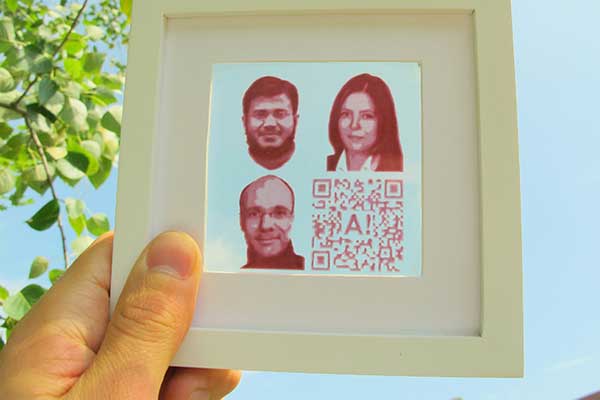Solar cells have been manufactured already for a long from inexpensive materials with different printing techniques. Especially organic solar cells and dye-sensitized solar cells are suitable for printing.
“We wanted to take the idea of printed solar cells even further, and see if their materials could be inkjet-printed as pictures and text like traditional printing inks,” says University Lecturer Janne Halme.
When light is absorbed in an ordinary ink, it generates heat. A photovoltaic ink, however, coverts part of that energy to electricity. The darker the color, the more electricity is produced, because the human eye is most sensitive to that part of the solar radiation spectrum which has highest energy density. The most efficient solar cell is therefore pitch-black.
The idea of a colorful, patterned solar cell is to combine other properties that take advantage of light on the same surface, such as visual information and graphics.
“For example, installed on a sufficiently low-power electrical device, this kind of solar cell could be part of its visual design, and at the same time produce energy for its needs,” suggests Halme.
With inkjet printing, the photovoltaic dye could be printed to a shape determined by a selected image file, and the darkness and transparency of the different parts of the image could be adjusted accurately.
“The inkjet-dyed solar cells were as efficient and durable as the corresponding solar cells prepared in a traditional way. They endured more than one thousand hours of continuous light and heat stress without any signs of performance degradation,” says Postdoctoral Researcher Ghufran Hashmi.
The dye and electrolyte that turned out to be best were obtained from the research group in the Swiss École Polytechnique Fédérale de Lausanne, where Dr. Hashmi worked as a visiting researcher.
“The most challenging thing was to find suitable solvent for the dye and the right jetting parameters that gave precise and uniform print quality,” says Doctoral Candidate Merve Özkan.
The research results opens up new possibilities for the development of decorative product- and building-integrated solar cells. The results were published in Energy & Environmental Science.
Reference(s):
Publication: Syed Ghufran Hashmi, Merve Özkan, Janne Halme, Shaik Mohammed Zakeeruddin, Jouni Paltakari, Michael Grätzel, Peter D. Lund. Dye-sensitized solar cells with inkjet-printed dyes. Energy Environ. Sci., 2016
Research story: Aalto University | July 26, 2016 (source)















Comments